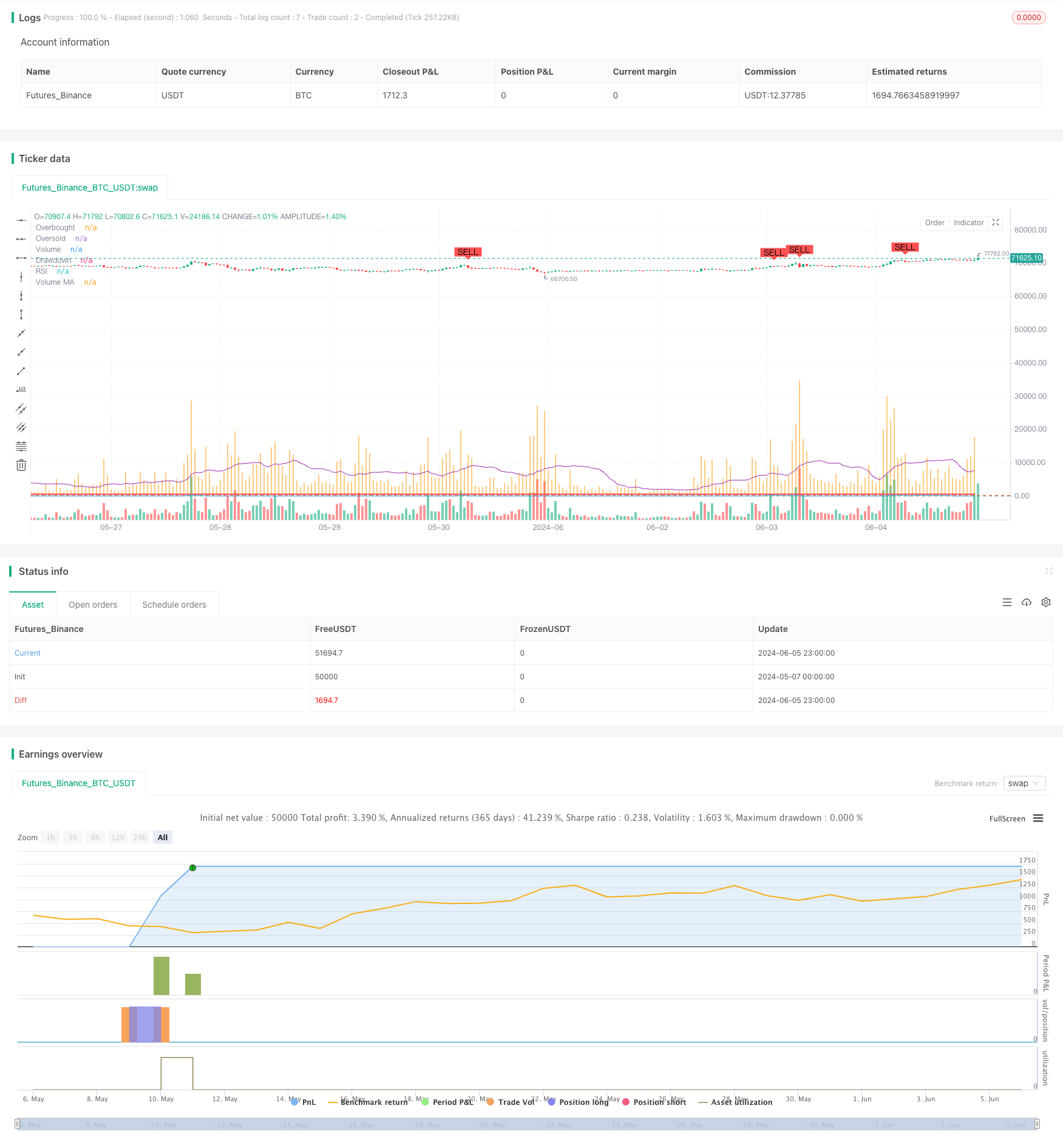RSI ダイナミック・ドラウダウンストップ・ロスの戦略
作者: リン・ハーンチャオチャン開催日:2024年6月7日15時47分51秒タグ:RSIマルチ

概要
この戦略は,リラティブ・ストラント・インデックス (RSI) とボリューム・ムービング・アベア (ボリューム・MA) を組み合わせて,市場における累積と配分の段階を特定し,買いと売却のシグナルを生成するワイコフ・メソドロジーに基づいている.さらに,戦略は最大引き上げ限界を設定することによってリスクを制御するために動的引き下げストップ・ロスのメカニズムを使用している.
戦略原則
- RSI指標とボリューム移動平均を計算する.
- RSIが過売りエリアを超え,ボリュームMAより大きくなると,市場の累積段階を特定し,購入信号を生成します.
- RSIが過買い領域を下回り,ボリュームがボリュームMAを超えると,市場の配分段階を特定し,売り信号を生成します.
- この戦略は,口座の最大自己資本と現在の引き上げを同時に追跡します.現在の引き上げが設定された最大引き上げ限界を超えると,戦略はすべてのポジションを閉鎖します.
- 購入ポジションは,配分期または最大引き上げを上回る利用期間に閉ざされ,売却ポジションは,蓄積期間に閉ざされ,または最大引き上げを上回る利用期間に閉ざされます.
戦略 の 利点
- RSIとボリューム指標を組み合わせることで,戦略は市場の蓄積と分配段階をより正確に把握することができます.
- ダイナミック・ドローダウンストップ・ロスのメカニズムは,戦略の最大ドローダウンを効果的に制御し,戦略全体のリスクを軽減します.
- 5分間の高周波データに適しており,市場の変化に迅速に対応し,ポジションを適時に調整することができます.
戦略リスク
- RSIとボリューム指標は,特定の市場条件下で誤った信号を生成し,戦略による不正な取引決定につながる可能性があります.
- 最大引き上げの
値の設定は,市場特性と個人リスクの好みに応じて調整する必要があります.不適切な設定は,早期にポジションを閉鎖したり,過度のリスクを負うことを引き起こす可能性があります. - この戦略は,不安定な市場で頻繁に取引信号を生成し,取引コストを増加させる可能性があります.
戦略の最適化方向
- 戦略のシグナルの精度を向上させるために,MACD,ボリンジャー帯など他の技術指標を導入することを検討してください.
- RSIとボリューム指標のパラメータを最適化する.例えば,RSIの長さ,過買い/過売値等を調整し,異なる市場状況に適応する.
- 引き下げストップ損失に加えて,リスクをさらに制御し利益を固定するために,ストップ損失または利益保護メカニズムを組み込む.
概要
RSIダイナミック・ドラウダウンストップ・ロスの戦略は,リスク制御のためにダイナミック・ドラウダウンストップ・ロスのメカニズムを使用しながら,RSIとボリューム指標を組み合わせて市場の蓄積と配分段階を特定する.この戦略は,市場動向とリスク管理の両方を考慮し,ある程度実用化している.しかし,戦略のパフォーマンスは指標パラメータと市場の特徴の選択に依存し,安定性と収益性を向上させるために継続的な最適化と調整を必要とする.
/*backtest
start: 2024-05-07 00:00:00
end: 2024-06-06 00:00:00
period: 1h
basePeriod: 15m
exchanges: [{"eid":"Futures_Binance","currency":"BTC_USDT"}]
*/
//@version=5
strategy("Wyckoff Methodology Strategy with Max Drawdown", overlay=true)
// Define input parameters
length = input(14, title="RSI Length")
overbought = input(70, title="RSI Overbought Level")
oversold = input(30, title="RSI Oversold Level")
volume_length = input(20, title="Volume MA Length")
initial_capital = input(10000, title="Initial Capital")
max_drawdown = input(500, title="Max Drawdown")
// Calculate RSI
rsi = ta.rsi(close, length)
// Calculate Volume Moving Average
vol_ma = ta.sma(volume, volume_length)
// Identify Accumulation Phase
accumulation = ta.crossover(rsi, oversold) and volume > vol_ma
// Identify Distribution Phase
distribution = ta.crossunder(rsi, overbought) and volume > vol_ma
// Plot RSI
hline(overbought, "Overbought", color=color.red)
hline(oversold, "Oversold", color=color.green)
plot(rsi, title="RSI", color=color.blue)
// Plot Volume and Volume Moving Average
plot(volume, title="Volume", color=color.orange, style=plot.style_histogram)
plot(vol_ma, title="Volume MA", color=color.purple)
// Variables to track drawdown
var float max_equity = initial_capital
var float drawdown = 0.0
// Update max equity and drawdown
current_equity = strategy.equity
if (current_equity > max_equity)
max_equity := current_equity
drawdown := max_equity - current_equity
// Generate Buy and Sell Signals
if (accumulation and drawdown < max_drawdown)
strategy.entry("Buy", strategy.long)
if (distribution and drawdown < max_drawdown)
strategy.entry("Sell", strategy.short)
// Plot Buy and Sell signals on chart
plotshape(series=accumulation, location=location.belowbar, color=color.green, style=shape.labelup, title="Buy Signal", text="BUY")
plotshape(series=distribution, location=location.abovebar, color=color.red, style=shape.labeldown, title="Sell Signal", text="SELL")
// Close positions if drawdown exceeds max drawdown
if (drawdown >= max_drawdown)
strategy.close_all("Max Drawdown Exceeded")
// Set strategy exit conditions
strategy.close("Buy", when=distribution or drawdown >= max_drawdown)
strategy.close("Sell", when=accumulation or drawdown >= max_drawdown)
// Display drawdown on chart
plot(drawdown, title="Drawdown", color=color.red, linewidth=2, style=plot.style_stepline)
関連性
- 複数確認の逆購買戦略
- 最良のトレードビュー戦略
- 先進的なダイナミックフィボナッチリトレースメント トレンド 定量的な取引戦略
- MA,SMA,MA傾斜,ストップ損失を後押しし,再入力
- ストップ・ロスの最適化モデルによるダイナミックRSIオーバーセール リバウンド・トレーディング戦略
- 短期取引戦略 ボリンジャー帯,移動平均値,RSIをベースに
- 2つの移動平均RSIモメントストラテジー EMAとトレンドラインブレイクに基づいて
- RSI-ATR モメント・ボラティリティ コンビネード・トレーディング・ストラテジー
- 多期移動平均値とRSIモメントクロス戦略
- ターンオーバー火曜日の戦略 (週末フィルター)
もっと
- BBの脱出戦略
- VWAP と RSI ダイナミック・ボリンガー・バンドは,利益とストップ・ロスの戦略をとる
- チェンデ・クロール ストップ ダイナミックATRトレンド 戦略をフォローする
- この戦略はチャイキンマネーフロー (CMF) をベースに取引信号を生成します
- トレンドフィルタピンのバー逆転戦略
- サポート・レジスタンスレベルでの逆転パターンに基づく定量的な取引戦略
- MA,SMA,MA傾斜,ストップ損失を後押しし,再入力
- クロスオーバー TSI戦略
- EMAの二重移動平均のクロスオーバー戦略
- Williams %R ダイナミック TP/SL 調整戦略
- VWAP トレーディング 戦略とボリューム アノマリー検出
- スーパートレンドとEMAの組み合わせ戦略
- TGT 価格下落に基づいた買い上げ戦略
- EMAクロスオーバーとRSIフィルターによる二重トレンド戦略
- EMAとパラボリックSARの組み合わせ戦略
- MACDとRSI 多フィルター・イントラデイ・トレーディング・戦略
- 2つの市場間の価格関係に基づく仲裁取引戦略
- RSIに基づく取引戦略で 利回りとストップロスを パーセントベースにする
- 最適化されたロング取引のためのMACDとマルティンゲール組み合わせ戦略
- エリオット・ウェーブストカスティックEMA戦略